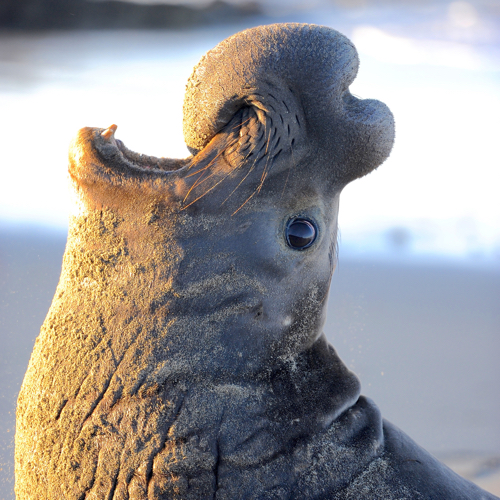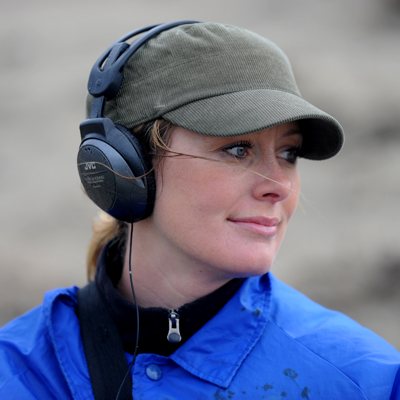In 1969, UC Santa Cruz biologist Burney Le Boeuf, a pioneer in the field of marine mammal behavior, published an article in Science reporting the first evidence of dialects in mammals other than humans.
His research on the calls male northern elephant seals use to threaten their rivals showed that the style of the animals’ percussion-like vocalizations depended on where they lived. So, for example, a listener could tell the difference between the threat call of a male elephant seal from Año Nuevo in Central California and one from Isla de Guadalupe in Mexico.
Almost 50 years later, UC Santa Cruz Ph.D. candidate Caroline Casey retraced Le Boeuf’s scientific footsteps and discovered the seals’ threat calls no longer had geographic distinctions. Instead, as the northern elephant seal population had increased, the males’ calls had grown more individualized and complex.
The study, published in Proceedings of the Royal Society of London B and authored by Casey, research scientist Colleen Reichmuth, professor of ecology and evolutionary biology Dan Costa and Le Boeuf — all of UC Santa Cruz — showed that animal communication didn’t remain static but shifted over time in response to changing environmental and social conditions.
Perhaps most importantly, it also demonstrated that scientists may need more than a single snapshot of animal behavior to understand how creatures communicate and live.
When Le Boeuf, then a professor of ecology and evolutionary biology, went to study the northern elephant seal calls in the 1960s, the seals were climbing back from near extinction and the population was about one third of what it is today. Armed with microphones and tape recorders, Le Boeuf traveled to Año Nuevo, San Miguel Island, San Nicolas Island and Isla de Guadalupe where he captured and analyzed the threat calls of hundreds of male northern elephant seals.
Vocalizations are important for male northern elephant seals. They are used to drive off would-be rivals for the dominant male’s harem of females, thus conserving energy for breeding and avoiding injury from a fight.
It’s as if a guy walked into a bar, decided to brawl with one of the patrons and called out, “I’m Sam.” His prospective target would then call back, “I’m Bud and we’ve fought before and you know happens when we fight so maybe you want to back off.”
But when Le Boeuf went to the breeding sites in the 1960s, the male population at each spot was small and not only were their calls simple but they were very similar to other male seals at the same site. It would be as if every guy in the same bar called out, “I’m Sam.” But that didn’t matter among the small group of males. They each recognized the other. There were no outsiders coming in.
In his 1969 paper, Le Boeuf predicted that as populations grew, the geographic dialects would disappear. Casey, who had read Le Boeuf’s studies, wanted to see if his prediction was correct.
Armed with a grant from the National Geographic Explorer Foundation, Casey and her co-advisor Reichmuth set off to the four sites Le Boeuf had examined almost 50 years earlier. At one point, they were dropped off on a remote beach on Isla de Guadalupe where there was no electricity, no water and no food. They spent two years recording elephant seals at each of these sites during the winter breeding season.
Back home, Le Boeuf turned over boxes of his research, including his reel-to-reel tapes of male threat calls. Casey and Reichmuth re-analyzed the data using more modern techniques and compared it to the calls of the 171 males they had recorded. They also relied on the rich trove of data on northern elephant seal behavior that has been documented by UC Santa Cruz researchers over the years.
What Casey and Reichmuth found was that as the northern elephant seal population grew and moved between breeding sites over the years (there are now more than 210,000 individuals), that instead of sounding similar to other males at their colony, individuals began producing calls that were really different from their neighbors. These differences between individual calls were good because they enable individual recognition of familiar rivals during the breeding season. As the population grew, it may have become more difficult to know who individuals were when competing for access to females. Over four generations, the calls became individualized and more complex and the geographic dialects vanished.
Having years of research from UC Santa Cruz was critical to the study, according to Casey.
“In order to understand the evolution of communication, we need detailed information that takes place over multiple generations,” Casey said. “That’s what this study does. It’s important to take what (scientists) have learned and evaluate it years later in order to see whether these observations are maintained over time.”




